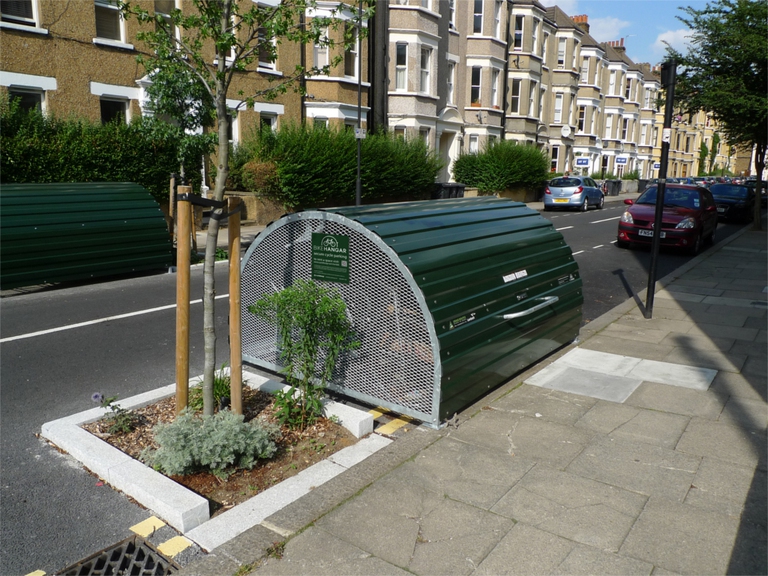
Milan has announced one of Europe’s most ambitious mobility schemes, known as Strade Aperte (open roads). Its goal is to reduce cars in phase 2 of the lockdown by increasing bike lanes and pedestrian areas.
After London, Dublin too is now testing “bikehangars” on streets. Dublin City Council chose a family to test the use of these covered bike parks. They are produced by Cyclehoop, the society which created car-shaped bike racks, to highlight that a car need that a car need the same parking space as 10 bikes. Awarded
After London, Dublin too is now testing “bikehangars” on streets. Dublin City Council chose a family to test the use of these covered bike parks. They are produced by Cyclehoop, the society which created car-shaped bike racks, to highlight that a car need that a car need the same parking space as 10 bikes.
Awarded for their design, the bikehangars has been designed to be placed in public spaces, such as parks and schools. It is an effective way to support safe bike parks on the road and to protect bikes from unfavourable weather conditions, theft or vandalism. They are extremely useful in case of rain: when you get back your bike, handlebars and saddle will not be wet.
The facility can house up six bikes, occupies half of a car parking space and is made of galvanised steel. The steel core is protected by a layer of zinc preventing it from getting rusty. A gas reducing human effort eases the opening of bikehangars’ doors.
Hiring bikehangars only costs 30 pounds per year. Cyclist not having a backyard, a garage or a place to keep their bikes safely, will avoid, for instance, lifting carrying bikes on their shoulder or passing through narrow spaces. It can be also useful to discourage cyclist to lock their bikes on road signs, as well as for outdoor apartment spaces, where an increasing number of citizens is asking for bike racks to be installed.
Bikehangars can also be useful to counter urban decay. Along with the colours for the decoration of the facility, there are other simple solutions, such as placing plant pots at the sides of the bikehangar, or more complex solutions, such as realising flowerbeds with trees next to the facility.
Siamo anche su WhatsApp. Segui il canale ufficiale LifeGate per restare aggiornata, aggiornato sulle ultime notizie e sulle nostre attività.
![]()
Quest'opera è distribuita con Licenza Creative Commons Attribuzione - Non commerciale - Non opere derivate 4.0 Internazionale.
Milan has announced one of Europe’s most ambitious mobility schemes, known as Strade Aperte (open roads). Its goal is to reduce cars in phase 2 of the lockdown by increasing bike lanes and pedestrian areas.
Formula 1, the world’s most important auto racing championship, has decided to turn the page and aim for carbon neutrality with the support of its teams, drivers and the whole racing circus.
Toyota and LifeGate began telling the story of hybrid mobility back in 2006, now, on the road to the Tokyo 2020 Olympics, they’re still treading the path of sustainable mobility. Here are the main steps of the journey.
Germany’s first solar bicycle lane could be the prototype for the roads of the future. The photovoltaic tiles melt snow and ice, and are capable of absorbing noise.
The Vespa is back in an electric version. Production has just started and the first models can be reserved online starting from October.
The city of Utrecht, in the Netherlands, is home to a bridge for cycling and walking that stretches over roof garden of a Montessori school. This project enhances practicality and will allow families to bring children to school by bike, passing through green areas. Despite their functionality, bridges are often seen as an infrastructure that is
The Lego hair bike helmet is the latest Internet craze. For now it’s just a prototype but production on a large scale will probably start soon.
Just as fires often give way to new growth, after the Dieselgate scandal, which saw Volkswagen cheating on US emission rules, the German car manufacturer radically changed course, beginning to focus on sustainable mobility. The German car company aims to propose thirty zero-emission models and produce at least one million battery electric vehicles by 2025. An ambitious mission
Sustainable, two-wheel mobility is triumphing in Copenhagen. After years of investments, policies, and infrastructural changes, bikes now outnumber cars in the city centre. The website Copenhagenize has released data linked to the number of vehicles entering the city centre, which are monitored by the city’s administration on a daily basis. Last year, 265,700 bikes have entered








